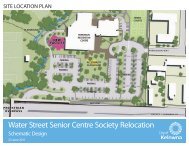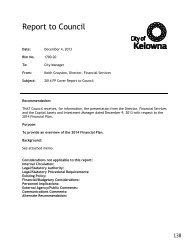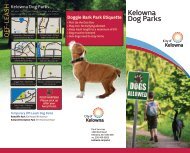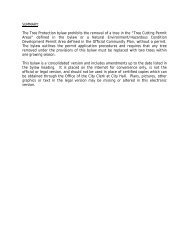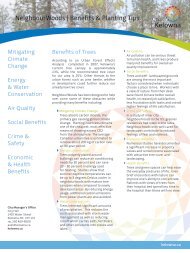Comprehensive Site Development Plan ... - City of Kelowna
Comprehensive Site Development Plan ... - City of Kelowna
Comprehensive Site Development Plan ... - City of Kelowna
Create successful ePaper yourself
Turn your PDF publications into a flip-book with our unique Google optimized e-Paper software.
Avocets at Glenmore Landfill<br />
6<br />
3.5 Conservation habitat at Glenmore Landfill<br />
If an engineered wetland at Glenmore Landfill is required to conserve the breeding population <strong>of</strong><br />
avocets then several factors must be considered. Several design factors are critical to consider<br />
when designing a wetland suitable for breeding avocets.<br />
Size: After studying the movements and territoriality <strong>of</strong> nesting pairs at Alki Lake, Weir<br />
and Gyug (1999) suggest that each nesting pair requires 0.5 ha <strong>of</strong> foraging habitat. If we assume<br />
12 breeding pairs (average number <strong>of</strong> breeding pairs in past 3 years) and 6 nonbreeding avocets (a<br />
total <strong>of</strong> 30 adult birds), then 6.6 ha would be required based on 0.5 ha/pair and chicks and 0.1<br />
ha/nonbreeder (Robinson and Oring 1997, Robinson et al. 1997). Since avocets tend to use about<br />
2/3 <strong>of</strong> suitable habitat available (Girard and Yesou 1991), 10 ha seems more appropriate.<br />
However, since other wetlands specifically engineered for nesting American Avocets have<br />
increased densities markedly (e.g., Tulare Lake Drainage District 1996), there is potential for<br />
providing habitat for more than 30 avocets in 10 ha.<br />
Surrounding Area: Land areas surrounding compensation habitat should be relatively<br />
flat and open with few trees so the area mimics prairie-like wetland habitat. In particular, all<br />
perch sites used by raptors (predators <strong>of</strong> avocets) should be cleared within 150 m from<br />
compensation habitat. To minimize human disturbance during nesting, the site needs to be<br />
designed so that there are no work operations carried out within 150 m <strong>of</strong> the site during the<br />
period when avocets are nesting (approximately May1 to August 15).<br />
Substrate: Clay or clay-silt should be used as substrate <strong>of</strong> compensation habitat as it is<br />
impermeable to water and thus stops underground water loss, forcing water losses through<br />
evaporation which aids in increasing salinity and alkalinity.<br />
Foraging Habitat: Shallow feeding areas <strong>of</strong> 1-17 cm depth are necessary in order for<br />
avocets to forage. Water depth in the majority <strong>of</strong> feeding areas could average 10 cm and be in the<br />
range <strong>of</strong> 5-13.5 cm deep. Small areas <strong>of</strong> deeper water (17-60 cm) should be scattered throughout<br />
the compensation habitat as some invertebrate species used as food may need deeper water at<br />
certain portions <strong>of</strong> their life cycles.<br />
Water Control: As water levels in compensation habitats fluctuate, it will be necessary<br />
to control water levels to keep nesting islands exposed in high water years and surrounded by<br />
water in dry years, to keep water depth in foraging areas at an optimal level, and to achieve a<br />
relatively constant water level through the incubation period. Outside the breeding season (May<br />
1-August 15) these water levels can be manipulated for other landfill management purposes.<br />
Other considerations with water level control are 1) salinity and alkalinity, which may be<br />
reduced when water is flushed through the system instead <strong>of</strong> allowing solutes to build up through<br />
evaporative water loss, 2) impacts on invertebrate prey abundance, and 3) vegetation control.<br />
The site should be designed so water levels can easily be manipulated, particularly to raise water<br />
levels on some occasions to prevent buildup <strong>of</strong> permanent vegetation on low nesting islands and<br />
in shallow foraging habitat.<br />
Water quality: Water should be highly alkaline (>400mg/L), highly saline (>12,000uS),<br />
have high Total Dissolved Solids and low Dissolved Oxygen (Ambrozy 1999).<br />
Manning, Cooper and Associates




